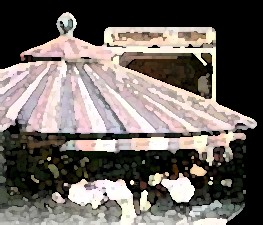|
A Brief Illions
History from "The Carousel Network"
At age fourteen, with seven years wood sculpting
experience, Marcus Charles Illions left Lithuania and traveled alone
to Germany. He soon moved on to England where he carved for the
renowned carousel and amusement manufacturer, Frederick Savage of
King's Lynn. In 1888, Illions traveled to the U.S. He may have
worked for others or set up his own carving shop to provide
amusement carvings on commission.
Around 1890 Illions began to work for Charles Looff. It was
undoubtedly Illions who took the early Looff style and transformed
it into the dynamic, vibrant creations that epitomize Coney Island
carvings. He continued to develop that style while working with
others, including his collaboration with Wm. F. Mangels on the
rebuilding of the fire-damaged Feltman carousel installed in Coney
Island in 1880 by Charles Looff. The resulting "Fabulous Feltman"
carousel is said to be one of the finest ever built.
Creativity was Illions forté, and he was known to be a brilliant,
strong-willed artist. The innovative Illions is credited with the
first use of gold leafing. His flying golden manes were soon copied
by other carousel makers and have become a hallmark of the Coney
Island style. Illions carousels and carvings are among the most
highly desired of all carousel art.
After leaving Looff and making carousel figures for and with others
for a few years, Illions began to produce figures to populate the
carousels being built by William Mangels, a Coney Island amusement
manufacturer, and the inventor of the Whip ride. Mangels did not
make carousel animals himself, but he understood amusement rides
and, with his son, took out U.S. patents for a jumping mechanism
that freed horses from the carousel platform and allowed them to be
set in motion.
Illions, the son of a horse trader, owned and rode horses. His
knowledge of equine anatomy and motion, combined with his artistic
eye and highly refined sculptor's skills gave his horses their
highly realistic, highly dynamic style. Mangel's jumping mechanism
gave him the opportunity to use his knowledge, artistry and skills
in the creation of an entirely new type of carousel horse, the
jumper, which Illions captured in the exuberance of its full gallop.
From 1909 to 1929, M.C. Illions & Sons produced some twenty
carousels and provided sets of figures to other manufacturers,
including Pryor and Church, the Pinto Bros., and the exciting
Steeplechase ride at Steeplechase Park in Coney Island. The largest
and finest of the factory offerings was its Supreme model with four
rows of highly-decorated horses.
With mass production techniques already drawing business away from
the more expensive hand-carved carousel manufacturers, the company
was ill-prepared for the ravaging effects of the stock market crash
and the ensuing depression. Although it continued to service its
older machinery until 1949 when Illions passed away, carousels were
not produced after 1929.
Six remaining Illions carousels can be seen at:
-
Riverside Park, Agawam, Mass., 1909
-
Wyandot Lake, Powell, Ohio, 1914
-
Geauga Lake, Aurora, Ohio, 1918 Illions
Supreme
-
Hempstead Lake State Park, NY, c. 1920
-
San Francisco Zoo, Calif., c. 1921
-
Flushing Meadows, Queens, NY
combined in 1964 from the remains of the
1903 Feltman and 1908 Stubbmann carousels
|

